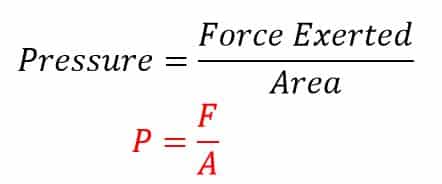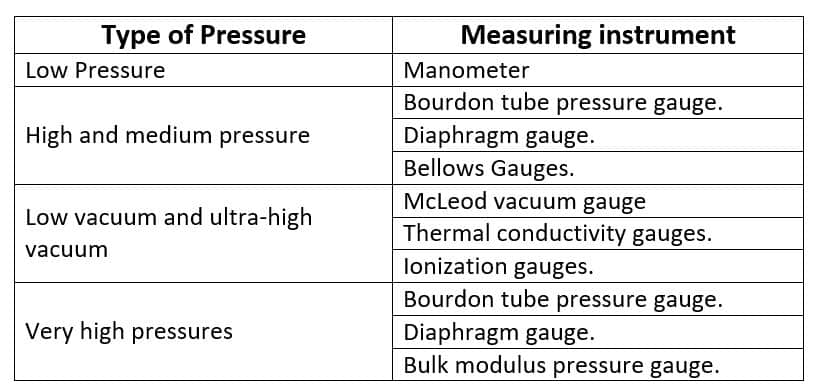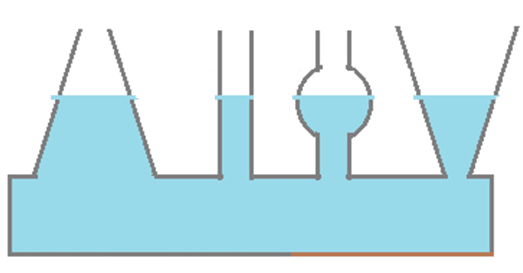Pressure is one of the most important parameters almost everywhere may it be industry, automobile, rocket science, and whatever you think of. The fluid, gas, and solids generate pressure when they experience compression. Hence, pressure measurement becomes one of the most important things.
The pressure clearly indicates the work done by pumps and compressors. It also measures the operating pressure in vessels.
What is Pressure?
Pressure is simply the amount of force applied to a unit area.

Units of Pressure
The common units of pressure are Pascal (Pa), Bar (bar), kg/cm2, Newton/meter2, psi ( pounds per square inch), mm of the mercury column, mm of the water column, or Torr. The most widely used units are kg/cm2, PSI, and mm of the water column.
Different types of pressure
There are 6 types of pressure.

1. Atmospheric Pressure
- The atmospheric pressure (atm) is the pressure exerted by the surrounding atmosphere on a surface.
- Atmospheric pressure is near 14.696 psi
- Because of changes in temperature and humidity, atmospheric pressure in the atmosphere keeps on changing. Atmospheric pressure also changes due to storms, tornados, and T-tsunami.
2. Vacuum Pressure
- The pressure below atmospheric pressure is termed vacuum pressure.
- Vacuum pressure is negative when expressed in terms of atmospheric pressure.
- Vacuum means the absence of pressure. A vacuum generates a force that sucks or pushes things towards the area generating the vacuum.
3. Gauge Pressure
- The difference between the measured pressure and atmospheric pressure is termed gauge pressure.
- Atmospheric pressure is 0 reference for gauge pressure and hence gauge pressure is always positive when compared to atmospheric pressure.
4. Absolute Pressure
- A perfect vacuum is a reference for absolute pressure (abs).
- Absolute pressure is the sum of atmospheric pressure and gauge pressure.
- P (abs) = P (atm) + P (gauge)
5. Differential Pressure
- The difference between any two pressures above atmospheric pressure is termed differential pressure (DP).
6. Compound Pressure
- The difference between two pressures, one above the atmosphere and one below the atmosphere is termed compound pressure.
Static and Dynamic Pressure
- In a moving fluid, static pressure is the direction perpendicular to the fluid’s motion, and dynamic pressure is the pressure the fluid can exert due to its kinetic energy when it strikes a surface. Static pressure generates in a fluid at rest, but dynamic pressure only exists when the fluid is moving.
- Dynamic pressure is pressure from multiple sources and/or angles. Static pressure is a constant pressure that does not change and is in one direction.
- The static pressure formula is
- Ps = p * g * h
Where, p-Density, g- Gravity, h – Height
- Ps = p * g * h
- Dynamic pressure formula is
- Pd = ½ * m * v2
Where, m-mass, v- velocity
- Pd = ½ * m * v2
- Another term called total pressure which is the sum of both pressure i.e. static pressure and dynamic pressure always remains constant in a given system.
Different Pressure Measurement Techniques
Many devices for pressure measurement have been invented which have various advantages and disadvantages. Pressure range, sensitivity, dynamic response, and cost vary by orders of magnitude depending on instrument design. The oldest type is a liquid manometer (a vertical tube filled with mercury). The following table lists the tools used in various situations.

What is the hydrostatic paradox?
For all vessels connected from the bottom, even though all have different shapes, the level of liquid in all vessels will be the same.

This typical property is known as the hydrostatic paradox and all vessels will exert the same pressure.
Read Next: